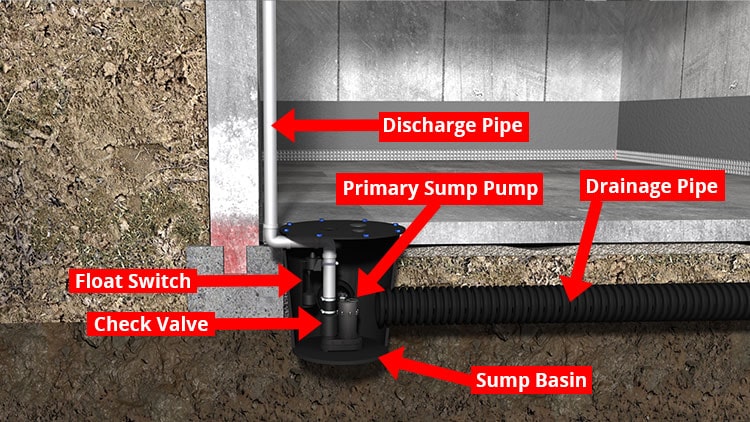Protect Your Property with a Basement Sump Pump

Share this Post
A basement sump pump installation may be the insurance you need to avoid costly flooding and water damage. We will explain the what, how, and why of sump pumps, including the common issues homeowners face after installing a sump pump system.
Is your house, apartment, condo, or business in a flood zone? Do you experience high rainfall or snowfall amounts throughout the year? Is your crawl space or basement located near the area’s water table? If so, your home is at risk of water damage.
In addition to rainfall amounts and flood zones, a burst or leaking pipe and a faulty water heater can cause crawl space or basement flooding. Many homeowners and business owners do not realize that a few inches of water can cause substantial and costly damage to a building.
So, how do you safeguard your property from water damage and avoid costly repairs? The answer is to have a basement sump pump installed. Sump pumps guard against water damage or flooding.
Table of Contents
What Are Sump Pumps?
Typically, sump pumps are placed in the lowest area of a crawl space or basement. This low area is referred to as a sump basin. Located inside the sump basin is the sump pump.

Sump pumps activate whenever the water level reaches a certain height in the basin. The pump switch is activated automatically, draws water from the sump pump basin, and transports the water outside your home, apartment, or building via PVC piping connected to a dry well or municipal storm drain.
How Do Sump Pumps Work?
There are two varieties of sump pumps – pedestal sump pumps and submersible sump pumps. A pedestal pump is placed in the sump basin; however, the motor is located on top of your pump, keeping it away from moisture. Conversely, submersible pumps have a waterproof encasement that allows the entire pump to be placed inside the sump basin.

Two types of switches activate the pump – a pressure-activated switch or a float-activated switch. A float-activated pump uses a floating device. The pump activates and removes water from the sump basin when the float rises. A pressure-activated switch uses a sensor that activates the sump pump whenever the water rises above the sensor.
Regardless of the type, a check valve or a back-flow valve must be installed on the discharge pipe. This valve prevents water from returning to the sump pump or basin once the pumping cycle ends.
Common Issues with a Basement Sump Pump
Basement sump pumps can fail; therefore, inspecting your sump pump periodically is vital.
The suction screen can become clogged, the float or pressure switch can become damaged, or the discharge pipe can become clogged. Typically, sump pumps will last around seven years before it needs to be replaced.
To ensure your basement sump pump will work when needed, you should inspect the sump basin and look for any debris that could damage your pump.
Once you verify the basin is clear, you should perform the following test. Pour water into the pump basin and ensure the sump pump activates.
Remain in the area until the basement sump pump completes its cycle, looking for leaks in the piping. Perform this inspection biannually or whenever flooding occurs to ensure your pump is in good working order.
How Often Should a Sump Pump Run?
A sump pump should run as often as necessary to keep the water level in the sump basin below the level of the pump’s inlet.
This may vary depending on factors such as the amount of water entering the basin, the basin’s size, and the pump’s capacity.
It is not uncommon for a sump pump to run several times a day in heavy rain or during a flood, but it should run less frequently during dry periods. If your sump pump runs frequently, it may indicate a problem, such as a clogged discharge line or a malfunctioning float switch.
It is essential to have your sump pump inspected and regularly serviced to ensure it is functioning correctly.
Why You Should Hire a Sump Pump Installer?
A basement sump pump requires plumbing in a discharge pipe. Most homeowners may not have the experience, tools, and supplies to handle the job. A professional installer will assure you of a proper installation.
This pipe will run from the sump pump, up and through the wall of your foundation, into an exterior drain, and then across your lawn to a dry well or your municipal storm drain.
The piping must have the proper pitch to drain effectively. Furthermore, a check valve must be installed in the piping to prevent the pumped water from returning to the sump pump at the end of a pumping cycle.

Sump pumps are electrical, meaning installers must wire the sump pump into your existing electrical system. Because water and electricity do not mix, the electrical wiring should be enclosed in a waterproof conduit, and a GFCI breaker must be installed. This Ground-Fault Circuit Interrupter automatically shuts off electrical power when a ground fault occurs.
Most homeowners or business owners lack the skills to install sump pumps. Therefore, a local sump pump installer should be contacted. A sump pump installer will ensure the basement sump pump is installed up to code.
To protect your house, apartment, or commercial property from the damaging effects of water, you should have sump pumps professionally installed. This pump will remove moisture from the lowest level of the building and minimize the risk of water damage.
Do you have a sump pump problem? Is your basement or crawl space in need of a sump pump?
Schedule a free, no-obligation inspection and quote at no cost.